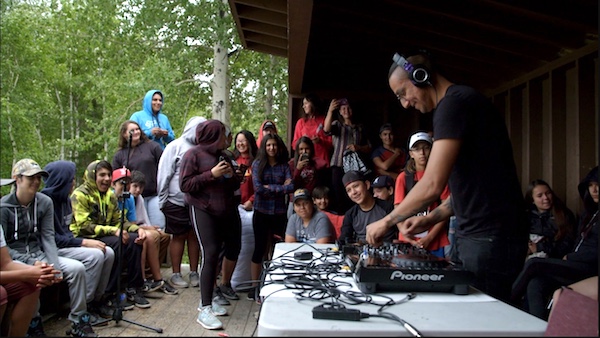
Joshua DePerry is a multi-talented guy. As the synopsis for Turning Tables says:
“In his hometown of Thunder Bay, Ontario, Joshua DePerry is known in the Anishinaabe community as a colourful ‘fancy dancer’ who impressively integrates contemporary dance moves at traditional pow wows. In Toronto, he is known as Classic Roots, an up-and-coming music producer and DJ who blends Indigenous sounds with modern techno and house music.”
Turning Tables shows DePerry strolling around the reservation, greeting friends and neighbours and showing kids how he works the turntables. We see him recording music in Toronto, performing in full regalia for a rapturous club audience, and dancing in a subway station. (“Nobody stopped him!” director Chrisann Hessing marvelled during the Q&A.)
I enjoyed Turning Tables immensely even though I don’t like techno. At just 16 minutes long, it left me wanting to know more about DePerry’s life and future achievements.
Turning Tables ends with DePerry about to go to Berlin. Hessing said that he did indeed go there, and that he’s there right now, already on his second visit to that city. She did film him going to the airport, but in the end she decided not to use that footage. She didn’t go to Berlin with him, either, because she felt that might intruding on his first-time experience there.
Hessing met DePerry in 2015 and since that time “We actually can’t stop working together. We’re continuing our collaboration.”
That collaboration includes a music video and the Turning Tables Tour which will take them the film and DePerry’s DJ equipment to a series of reservations.

“Joshua’s story is exemplary in that he has proven through his musical career, ambitions, and simply through his existence, that it is possible to come out of a place of limited opportunity and create a successful and fulfilling life.”
“The tour is designed to bridge the gap in accessibility between Indigenous Youth and role models like Josh. The communities we intend to visit include remote areas with lack of resources. . .”
That quote about the Turning Tables Tour comes from the film’s excellent web site, which is bursting with information and high-quality photos. Bravo for that!
Turning Tables is being shown at RIDM, Montreal’s documentary film festival, along with two other shorts. Teta, Opi & Me, by Tara Hakim, is the love story of her Austrian grandmother and Arab grandfather. Dreaming Murakami, directed by Nitesh Anjaan, is about Mette Holm, the Danish translator of the Japanese novelist Haruki Murakami. It’s 57 minutes long.
Turning Tables
Country : Canada
Year : 2018
V.O : English
Duration : 16 Min
Cinematography : John Minh Tran
Editing : Ryan J. Noth
Production : Tanya Hoshi
Sound Design : David Hermiston
Turning Tables
Friday, Nov. 16, 2018, 8:15 p.m.
Cinéma Du Parc – Salle 3
3575 Park Ave, Montreal, QC H2X 3P9
Visit the RIDM web site for more information about the festival.
<p><a href=”https://vimeo.com/258122843″>Turning Tables Trailer</a> from <a href=”https://vimeo.com/chrisannhessing”>Chrisann Hessing</a> on <a href=”https://vimeo.com”>Vimeo</a>.</p>

















